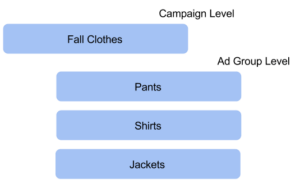Building a paid search campaign is by no means a simple process. There are a lot of moving parts within ad platforms themselves. If you tack on business objectives, goals, and needs, it’s easy for your organizational process get muddied quickly. This post outlines methodology for building campaigns using major themes in a business’s product or service offerings.
Why build by theme?
Before we talk about why a campaign should be built by theme, we need a common understanding of what a theme is in terms of paid search campaign structure. For the purpose of campaign construction, a theme is essentially a product and/or service category. For example, a retailer may have “Fall Clothes” as a theme. It’s important to plan around business objectives and take the time to organize keywords accordingly as it will ultimately drive the framework.
So what does a campaign built out by theme look like? The diagram below outlines an example structure for an imaginary clothing retailer. At the campaign level is your theme, which is the skeleton of the structure. At the ad group level is where you will want to do segmentation of keywords and match them to specific products or services if warranted.
What are the alternatives?
Building a campaign by product:
Using this methodology is usually best when promoting a small number of products. It allows you to control geo-targeting for specific products as well as control the advertising budget on a per-product basis. This allows for a very granular ad group structure with maybe one or two keywords per ad group.
Building a campaign by landing page:
This method is for people who want to test specific landing pages on separate budgets as well as have control over geo-targeting and other campaign-level settings on a per-page basis.
Building a campaign by acquisition method:
Generally, this is as simple as having a campaign for customer acquisition, retention, retargeting, or whatever your acquisition method may be. Like building a campaign by theme, this caters to themed creative very well based on where a customer is in the funnel.
Logistical Differences
Creating a campaign based around large thematic elements means that you no longer control specific products at the campaign level and instead do this at the ad group level.
Who is this best for?
Building campaigns by major themes doesn’t make sense for everyone. Generally, it is best for a company that has a wide breadth of products or sells in multiple markets. Some examples of this include large retailers, automotive parts sellers, and many service businesses (e.g. contractors or law firms).
Why hyper-segment?
Hyper-segmentation is generally used for two reasons, either to break budgets out by business objectives or categories or because it is necessary to segment out geo locations. In this case, building a campaign by theme achieves the former for companies who operate within departments or have distinct product categories.
Pros:
- Easily adjust along organizational or product category lines
- Allows for segmented and specific themes in ad creative
- Simple to conceptualize, the themes are usually major factors of a business
- Has benefits for reporting
- Easily use filters to construct pivot tables across a potentially large keyword base
- Data is essentially pre-segmented into a big picture snapshot with the flexibility to drill in at the ad group level
Cons:
- Easy to over-simplify when granularity is needed
- Not ideal for businesses with a low breadth of products
Naming Conventions
One of the most important things to keep in mind when creating any campaign is your naming convention. In order to provide the maximum flexibility, here are a couple of suggestions:
- Include the major theme in both your campaign name and the ad group names within. This allows you to filter by the campaign name at the ad group level, which can be useful when you’re manipulating the data or making changes across several ad groups at a time.
- If you have multiple locations, include the geographical locations as part of your naming convention. Again, this helps immensely when you want to pivot or filter data.
As an example, let’s say we have broken our market up into two major chunks: East and West (let’s call these markets) and that we have two campaign themes. Our syntax might look something like:
Campaign level: State – Theme – Market
California – Summer Clothes – West
Washington – Summer Clothes – West
Ad Group level: State – Theme – Keyword Group – Market
California – Summer Clothes – Skirts – West
Washington – Summer Clothes – Skirts – West
This creates great consistency between campaigns and ad groups as well as caters to the filter, delimit and pivot functions within the AdWords and Bing UIs, third party tools, and Excel.
The methodology presented here is just one way to build out a paid search campaign and foster a strong and simple keyword organization. When you or a client next says, “Let’s amp up our Fall keywords considering it’s August already!” you’ll be all over that and rocking it out like no other.










